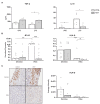Increased Expression on Innate Immune Factors in Placentas From HIV-Infected Mothers Concurs With Dampened Systemic Immune Activation
- PMID: 32983090
- PMCID: PMC7477039
- DOI: 10.3389/fimmu.2020.01822
Increased Expression on Innate Immune Factors in Placentas From HIV-Infected Mothers Concurs With Dampened Systemic Immune Activation
Abstract
Innate immunity is one of the main protection mechanisms against viral infections, but how this system works at the maternal-fetal interface, especially during HIV infection, is still poorly known. In this study, we investigated the relationship between pregnancy and innate mechanisms associated with HIV immunity by evaluating the expression of DAMPs, inflammasome components and type I/III IFNs in placenta and serum samples from HIV-infected mothers and exposed newborns. Our results showed that most of these factors, including HMGB1, IL-1, and IFN, were increased in placental villi from HIV-infected mothers. Curiously, however, these factors were simultaneously repressed in serum from HIV-infected mothers and their exposed newborns, suggesting that pregnancy could restrict HIV immune activation systemically but preserve the immune response at the placental level. An effective local antiviral status associated with a suppressed inflammatory environment can balance the maternal immune response, promoting homeostasis for fetal development and protection against HIV infection in neonates.
Keywords: DAMPs; HIV-infection; cord blood; inflammation; newborns; placental tissue.
Copyright © 2020 Pereira, Branco, Manfrere, de Lima, Yoshikawa, Milanez, Pereira, Sotto, Duarte and Sato.
Figures





References
-
- Report Global. UNAIDS Report on the Global AIDS Epidemic 2018. Geneva: UNAIDS; (2018).
Publication types
MeSH terms
Substances
LinkOut - more resources
Full Text Sources
Medical

